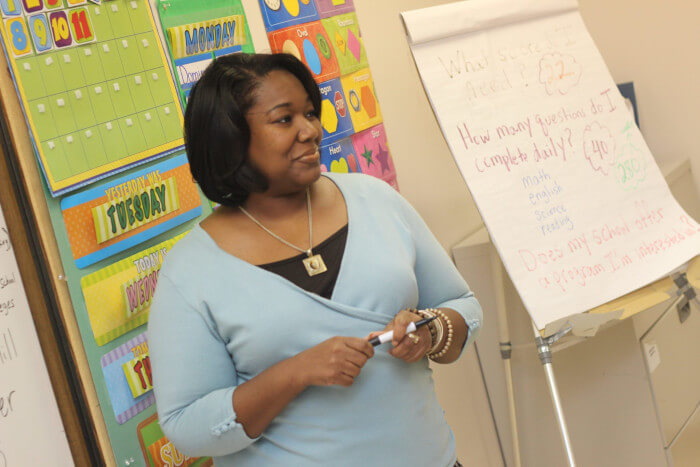Before becoming an English and social studies teacher, I worked with special needs students as a paraprofessional for five years. This job made me a better teacher by arming me with the tools I needed to build a future inclusive classroom.
Our school systems have come a long way and are continuously making strides in including all students of varying abilities, but teachers may not get the training they need to implement successful strategies. Unfortunately, some students with special needs ends up feeling left out.
Research shows that inclusiveness creates a more accepting school culture and sense of belonging for students with or without special needs. This is one reason why more and more schools are abandoning or limiting gifted pull-out programs in favor of inclusive classroom environments.
Here are some teaching strategies to create a welcoming classroom for all.
6 key features of an inclusive learning environment

1. Establish relationships with paraprofessionals
Fortunately, many schools have paraeducators who can help out special needs students in the classroom. Whether it’s a paraprofessional who works one on one or with multiple students, these educators have an integral job and are there to help.
But sometimes, paraprofessionals struggle to know how involved they should be — and trying
If you have a paraprofessional in your classroom, you have another adult who is more than capable of helping with tasks like handing out papers and answering questions. Try to include them whenever you can — they’ll make your job easier.
Letting them be available to other students and involved in classroom routines provides paras with a classroom sense of belonging and can also show pupils that there’s another adult who is there for them, too.
These simple measures make the paraprofessional feel like a part of the learning environment instead of just an individual helper. Try showing the students that this hard-working individual is another resource for all so that everyone can benefit from their presence.

2. Implement community-building routines
Earlier posts, like this one, explored the importance of icebreakers and how they can help develop a community. Icebreakers are also a great way to establish an inclusive classroom because they allow students and teachers to get to know each other.
All of these relationships can grow through community activities. Some students won’t take the effort on their own to learn about someone who’s different than them. But with a community-building activity, they might find that they have more in common with their peers than they previously thought — regardless of their backgrounds or needs.
For more ideas on community activities that will get your kids moving, check out How to increase student engagement in the classroom.

3. Differentiate instruction
The best clear-cut definition of differentiated instruction that I’ve ever read comes from education expert Carol Ann Tomlinson. In her book How to Differentiate Instruction in Academically Diverse Classrooms, she states that the term means “’shaking up’ what goes on in the classroom so that students have multiple options for taking in information, making sense of ideas, and expressing what they learn.”
Like ALL classrooms, mine had students with varying abilities. I had a few students with dyslexia and other reading and writing difficulties. I also had students who were on the gifted spectrum.
One way I differentiated instruction was with spelling tests by assigning different colors for students of certain aptitude levels. Giving them all the same vocabulary list didn’t always accomplish what I wanted. But offering a variety of lists was super helpful and targeted specific needs.
This does require more time, which you understandably may not have, but there are also many ways to differentiate instruction without creating extra assignments. For starters, some students just need a little more support than others. One student may require note outlines, and another may just need a blank piece of paper.
Lots of public schools have Individualized Education Programs (IEPs) with many differentiating instruction ideas already in place. If you have a student who could benefit from an individualized plan (who doesn’t have one already), it might be worth the recommendation.

4. Give students choices
Did you know that offering student choice has been linked to increased motivation and differentiation? Choices can be incredibly beneficial because you can cater them to the student’s strengths. You can usually do this by creating a couple of options that still cover the same standard.
An excellent example of this is the school science fair. One option for students might be to write a paper on the experiment. Another option is to create a visual board showing the steps and explaining them in front of the class. Yet another opportunity might involve demonstrating the experiment and videotaping it.
You can also offer student choices that are based on multiple intelligence theories. If you’re unfamiliar with this term, it was coined by Harvard educator Howard Gardner, who believed that all students learn differently. He broke up the way we access information into categories, including kinetically, linguistically, visually, and more.
There’s even a quiz that students can take to discover their best learning style. Here is one multiple intelligences assessment that you could try with your students.

5. Establish clear guidelines for Tribes
You could also create an inclusive classroom environment by making sure that you have clear and concise expectations for behavior that includes teaching tolerance. One popular model that many schools have adopted is called Tribes.
In this curriculum, there are five golden rules that cover most behavioral scenarios while promoting learning and respect. They are:
- No put-downs
- Attentive listening
- Mutual respect
- Appreciations
- The right to pass
Posting these expectations in your room serves as a reminder for how we should treat one another, and the program also comes with a whole curriculum of icebreakers and activities.
Note that you can teach this curriculum to any grade, and it can even benefit adults.

6. Invite a motivational guest speaker
Another idea is to invite a motivational guest speaker who can talk about themes surrounding inclusion. Perhaps the presenter has a disability themselves or overcame an obstacle, like bullying. You could even consider hosting a representative from Autism Speaks or an athlete from the Special Olympics. There are plenty of options to explore here no matter what grade level you teach.
Having a live person speak to your classroom — as opposed to only reading about topics in a book — could be incredibly powerful for the kids. The lessons might even stick well into adulthood.
Your efforts will have a significant impact
Props to you for trying your best to create an inclusive classroom — because this action is beneficial for everyone involved, and the changes you make are bound to have positive results.
Diversity and inclusion make our world and classrooms beautiful. In the long term, creating an inclusive class require huge changes, but it all begins with small, impactful actions.
If we can do our best to take notice and try to create an inclusive learning environment, maybe we can carry on that mentality into the bigger classroom: our world.
Photo credit: Naomi Shi / Pexels.com
Classroom Management


